Presidential hopeful pledges US$275bn for infrastructureUSAF signs Atkins team to support construction worldwideMasterplan chosen for $2.2bn San Diego airport expansionHNTB picked for 135-mile section of Californian high-speed railBalfour Beatty wins contract for Fort Worth tower
Construction spending in the USA logged robust monthly and year-on-year growth in October, with gains in the residential, non-residential and public-sector categories.
The total is the highest since 2007, says Associated General Contractors of America, with the latest increases suggesting that contractors will have plenty of work in 2016. However, concerns are escalating regarding the availability of skilled workers in sufficient numbers to cope with existing and future projects.
“The October data were positive across the board, with robust growth for the month and year in residential, private non-residential and public construction,” said Ken Simonson, the association’s chief economist. “The pause that had appeared in private and public non-residential spending for several months seems to have ended.”
Construction spending in October totalled US$1.107 trillion (£734bn) at a seasonally adjusted annual rate, 1% higher than the September total and 13% higher than in October 2014, Simonson said. He noted that the total was the highest since December 2007.
Private residential spending increased 1% for the month and 16.6% over 12 months. Simonson said that demand for multi-family residential construction grew at a particularly robust rate – 1.4% for the month and 27.9% year-on-year – while single-family spending rose 1.6% and 11.4%, respectively.
Private non-residential construction spending gained 0.6% for the month and 15.3% over 12 months. Simonson observed that there were year-on-year increases in every private non-residential category except ‘commercial’ (retail, warehouse and farm) construction. The largest category – manufacturing construction – soared 3% and 40.5%, respectively.
Public construction spending rose 1.4& from a month before and 6.1% from 12 months earlier. Of the two biggest public categories, highway and street construction increased 1.1% and 6%, respectively, while spending educational facilities was flat for the month and up 8.4% for the year.
“The breadth of the expansion and the large number of categories with double-digit increases suggests that construction will continue growing well into 2016,” said Simonsob. “My only concern is whether contractors will be able to find enough qualified workers to undertake all of the projects.”
Indeed, 78 percent of firms reported they expected workforce shortages to remain severe or get even worse during the coming year as part of a workforce survey the association released in September.
“We are reaching the point where demand for construction services is going to outstrip the supply of qualified and available workers,” said Stephen Sandherr, the association’s chief executive officer. “Once that happens, firms are going to bid on fewer projects, slow their schedules and worker shortages will bring more pressure on contractors to adjust their prices to meet the challenge of finding qualified craft professionals to perform the work.”
































